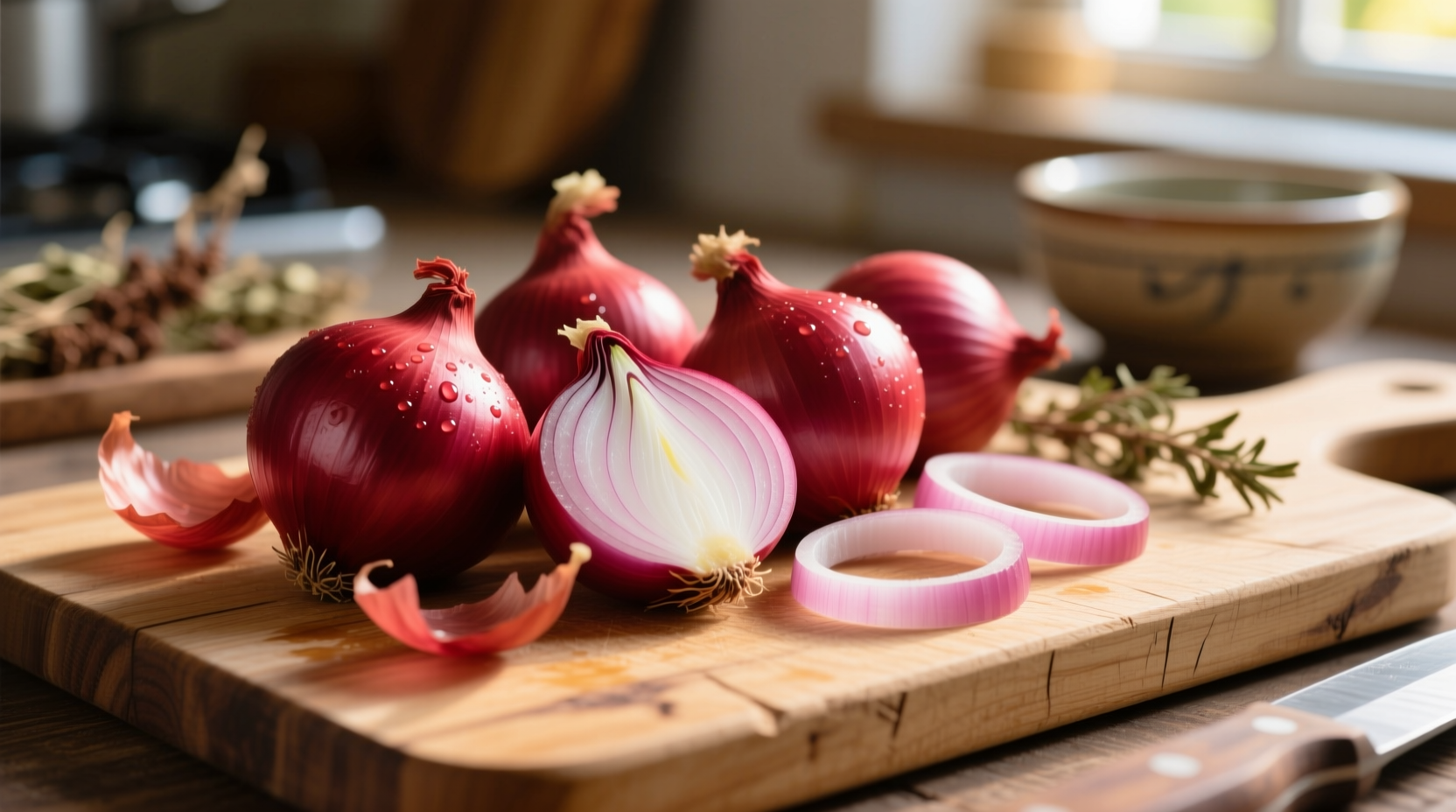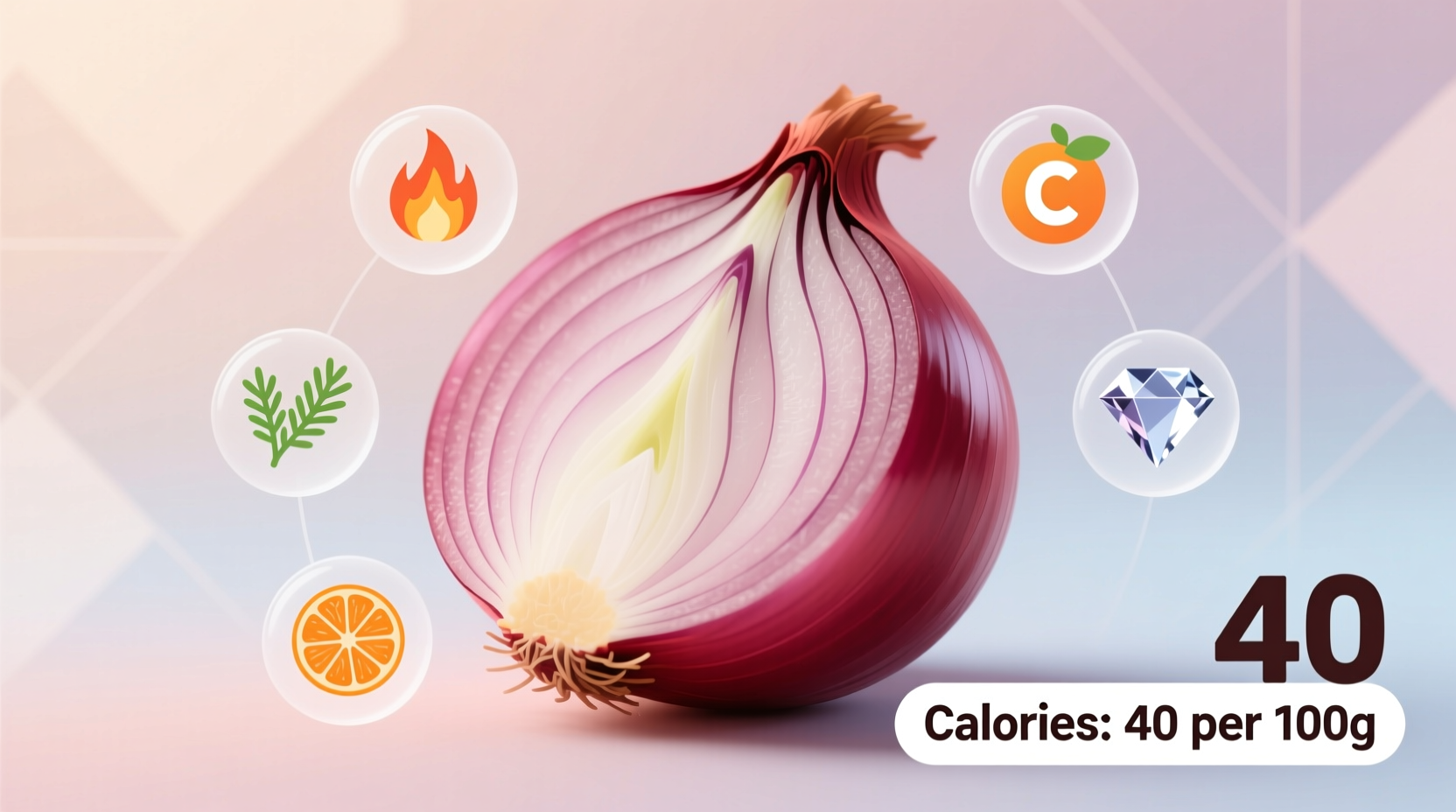Discover exactly how red onions fit into your nutritional plan with precise calorie counts, serving size breakdowns, and practical usage tips that help you maximize health benefits while maintaining your dietary goals.
Red Onion Nutrition: The Complete Calorie Breakdown
When tracking your daily nutrition, knowing the exact caloric content of ingredients like red onions helps make informed dietary choices. Unlike many vegetables that vary significantly in size, red onions provide consistent nutritional value that's valuable for meal planning.
According to the USDA FoodData Central database, the calorie content of red onions remains remarkably consistent across different measurements:
| Serving Size | Calories | Carbohydrates | Fiber |
|---|---|---|---|
| 100 grams (raw) | 40 kcal | 9.3 g | 2.0 g |
| 1 medium onion (110g) | 44 kcal | 10.2 g | 2.2 g |
| 1/2 cup chopped (58g) | 23 kcal | 5.4 g | 1.2 g |
| 1 cup chopped (116g) | 46 kcal | 10.8 g | 2.3 g |
How Red Onions Compare to Other Onion Varieties
Many people wonder if red onions differ nutritionally from yellow or white onions. The truth is they're remarkably similar in calorie content, with minor variations in phytonutrient profiles:
- Red onions: 40 calories per 100g, higher in anthocyanins (antioxidants that give them their color)
- Yellow onions: 42 calories per 100g, slightly higher in sulfur compounds
- White onions: 43 calories per 100g, milder flavor profile
The slight differences in calorie count (1-3 calories per 100g) are nutritionally insignificant. What matters more is that red onions contain unique antioxidants not found in other varieties, making them particularly valuable despite nearly identical calorie counts.

Practical Calorie Management with Red Onions
Understanding how red onions fit into your daily nutrition requires context beyond just the numbers. Here's what matters most for practical dietary planning:
When Red Onion Calories Actually Impact Your Diet
For most people, red onions contribute minimally to daily caloric intake. A standard salad topping (2-3 tablespoons chopped) adds only 8-12 calories. However, certain situations make tracking these calories more relevant:
- Strict calorie-restricted diets (under 1,200 calories daily)
- Ketogenic or low-carb diet planning where every gram of carbohydrate counts
- Professional athletic nutrition planning requiring precise macro tracking
Maximizing Nutritional Value Per Calorie
Red onions offer exceptional nutrient density. That same 44-calorie medium onion provides:
- 13% of your daily vitamin C needs
- 4% of daily potassium requirements
- Significant quercetin and anthocyanin antioxidants
- Nearly 2 grams of dietary fiber
This nutrient-to-calorie ratio makes red onions one of the most nutritionally efficient ingredients you can add to meals.
Real-World Applications: Using Red Onions Strategically
Knowing the calories is just the beginning. Here's how to practically incorporate red onions into various dietary approaches:
For Weight Management
Add 2-3 tablespoons of raw red onion to meals for flavor enhancement without significant calorie impact. The fiber content (1.2g per 1/2 cup) helps increase meal satisfaction. Raw red onions in salads or salsas provide crunch and flavor while contributing minimal calories.
For Low-Carb and Keto Diets
With approximately 7.5g net carbs per 100g, red onions can fit into moderate low-carb plans but require careful portion control in strict keto diets. Consider using 1-2 tablespoons in recipes rather than larger servings to stay within carb limits while gaining flavor benefits.
For Blood Sugar Management
The moderate glycemic load of red onions (GL of 1 for a 1/2 cup serving) makes them suitable for most blood sugar management plans. The chromium content may actually help improve insulin sensitivity according to research published in the Journal of Nutrition and Metabolism.
Preserving Nutritional Value: Preparation Matters
How you prepare red onions affects their nutritional profile. Research from the University of Guelph shows that certain preparation methods maximize health benefits:
- Raw consumption: Preserves maximum vitamin C and heat-sensitive compounds
- Slicing and waiting 10 minutes: Allows beneficial sulfur compounds to develop
- Light cooking: Enhances antioxidant bioavailability while minimizing nutrient loss
- Avoid prolonged cooking: Prevents significant reduction in quercetin content
A study published in the International Journal of Food Science found that raw red onions retained 100% of their quercetin content, while boiling reduced it by 26% and frying by 19%. For maximum nutritional benefit, use raw or lightly cooked red onions in your recipes.
Red Onion Nutrition in Context: What the Research Shows
Multiple studies confirm the health benefits of red onions beyond their basic nutritional profile. Research from the American Society for Nutrition demonstrates that regular onion consumption correlates with improved cardiovascular health markers.
The unique anthocyanins in red onions provide additional benefits not found in other onion varieties. According to a 2022 review in Nutrients, these compounds demonstrate anti-inflammatory properties and may help reduce oxidative stress. This makes red onions particularly valuable despite their nearly identical calorie count to other onion types.
Practical Tips for Daily Incorporation
Here's how to seamlessly add red onions to your daily routine while staying mindful of your nutritional goals:
- Add 2 tablespoons to morning omelets for flavor without significant calorie impact
- Include in green salads (1/4 cup provides only 23 calories)
- Create quick pickled red onions for tacos and sandwiches
- Blend into fresh salsas for added nutrition and color
- Use as a garnish for soups and stews for flavor enhancement
Remember that the average person consumes only 1-3 tablespoons of red onion per serving in most recipes, contributing just 8-25 calories to the entire dish. This minimal addition brings significant flavor and nutritional benefits without substantially affecting your daily calorie count.











 浙公网安备
33010002000092号
浙公网安备
33010002000092号 浙B2-20120091-4
浙B2-20120091-4